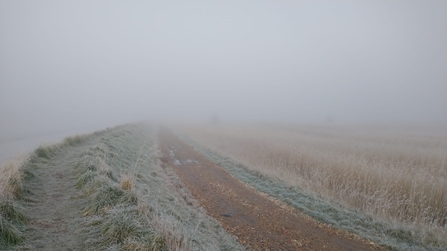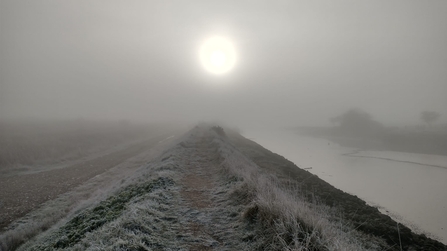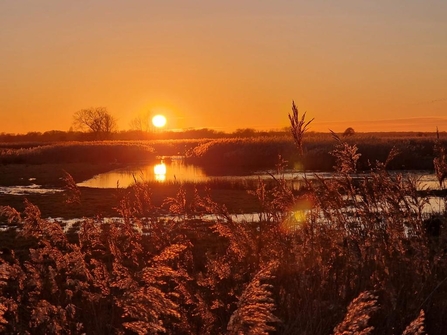Weekly wild news from our reserves - 10 February 2023
Sunset at Carlton Marshes, Anneke Emery
Joe Underwood and the South East Suffolk team found some stag beetle larvae at Newbourne Springs nature reserve. They were in an old, decaying oak gate post the team were replacing, and were found along with a lesser stag beetle. Stag beetles are incredible insects that only live for a month or two as adults but spend most of their life (5-7 years) as larvae. They need rotting wood, which is why leaving dead trees standing, and dead wood lying around, is so important – not just for stag beetles, but lots of other species too. The team carefully extracted the larvae from the post and put into a hollow log nearby. They used the rotting wood from the post they’d come from to create a shelter for them, and then covered them with soil.
You can find out more about stag beetles and learn how to make your own stag beetle log pile here.
Wild Work Day at Blaxhall Common
Ben and Ella welcomed members of the team at Tyson Cooper to Blaxhall Common for a Wilder Work Day. The team did a fantastic job removing pine seedlings. If the seedlings were allowed to grow, then the common would soon become forested, removing the vital open habitat needed for birds such as woodlark and nightjar and reptiles such as lizards and adder. Wild Work Days are great ways to bring colleagues together while doing valuable conservation too.
Wildlife wonders at Trimley Marshes nature reserve
Many thanks to photographer Ian Pope who has sent us some lovely photos from Trimley Marshes this week.
Last day of the winter work season at Blaxhall Common
Like much of the county’s reserve teams, the South East team is wrapping up the last of the winter work. At Blaxhall Common, the woodlark will be on their breeding territories soon, so we will not want to disturb them. Spring is on the way!
Spring is on the way at Newbourne Springs
Rachel Norman, South East Warden, reports, “It’s stunning at Newbourne Springs this afternoon. Birds are noticeably more vocal now the sun is shining. Siskins, blackbirds, redwings, long tailed tits, robins, thrushes, and the drilling from woodpeckers have all been seen and heard.”
If you can get out to a reserve this week, let us know what you see and hear on our social media channels.
Superb sedge
Debs Crawford has captured these characterful sedges at Market Weston Fen. In these photos you can see greater tussock sedge in the meadow, and near the pond we have greater tussock sedge and saw sedge (or great fen sedge), both are SSSI species for the fen. Great fen-sedge is a tall and stout plant, with long, sawtooth-edged leaves. It forms dense stands in lowland fens and around the margins of lakes. It is especially common in East Anglia where it was cut for thatching material because it was more flexible and durable than reed.
The softrak returns to Hen Reedbeds
Warden Dan Doughty sent in these photos of the Softrak working at Hen Reedbeds. This machine is important in conservation as it can access marshy, wet reedbeds where other machinery would get stuck. It helps us maintain a diverse age structure of reeds, cutting areas to stimulate new reed growth and open up areas within the reedbed for other species to exploit.
Also at Hen, Dan enjoyed an early morning frosty sunrise – the ice on the reeds is magical.

Frosty hen reedbeds, Dan Doughty

Frosty sunrise at Hen Reedbeds, Dan Doughty
Machinery can make the best hide. Dan also spotted this curious stonechat at Hen Reedbeds.

Stonechat viewed from the softrak, Dan Doughty
Deadwood for minibeasts at Carlton Marshes
The North East team have been installing deadwood for a mini-beast area at Carlton Marshes. Deadwood is incredibly important. It has been estimated that 13% of all species of plants and animals known in the UK are directly dependent on deadwood habitats.
There will be three minibeast homes around the short loop from the visitor centre for people to explore and learn about the invertebrates living on the reserve.

Mini beast logs at Carlton Marshes, Lewis Yates
Also at Carlton Marshes, we have a digger on site clearing ditches on Whitecast Marsh. The digger has been shadowed by an opportunistic heron that’s been fishing out tasty morsels as work continues.

Heron and digger at Whitecast Marsh, Lewis Yates
Our digger driver, Tim Reid, captured the heron tackling an eel – who wasn’t going to be eaten without a fight!
Heron eating an eel (https://youtu.be/rc7GcforN0E)
Heron eating an eel, Tim Reid
And finally...
Our reserve intern, Anneke Emery, has captured a glorious sunset at Carlton Marshes.

Carlton Marshes sunset, Anneke Emery





























